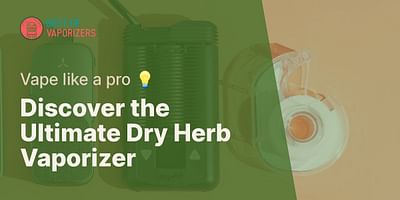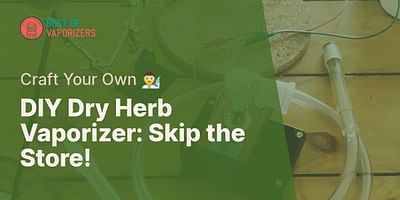Rodger Carter is a recognized professional in the field of vaporizer testing and reviewing. With an unerring eye for high-quality products, he is celebrated for his candid and impartial assessments. His interest in vaporizers began as a personal pastime and swiftly evolved into a full-time profession. Rodger is consistently on the hunt for the most recent models and breakthroughs in the industry.
Hey there! I'm Tommy Vapor, and I'm here to give you the lowdown on how a dry herb vaporizer works. If you're new to the world of vaporizers or just curious about how they operate, you've come to the right place.
A dry herb vaporizer is a device designed to heat your favorite herbs or botanicals without burning them. Instead of combustion, which produces smoke and harmful byproducts, a vaporizer uses heat to release the active compounds in your herbs, creating a flavorful and smooth vapor.
So, how does it work? Let's break it down step by step:
1. Heating Chamber: Every dry herb vaporizer has a heating chamber where you place your finely ground herbs. This chamber is usually made of ceramic, stainless steel, or a combination of both. The material is important because it ensures even heat distribution and preserves the flavor of your herbs.
2. Temperature Control: One of the great things about dry herb vaporizers is that they allow you to control the temperature. Different herbs have different vaporization points, so being able to adjust the temperature gives you the freedom to customize your experience. Most vaporizers have preset temperature settings, while others offer precise temperature control.
Temperature Control Settings
3. Heating Element: Inside the heating chamber, you'll find a heating element. This element can be a ceramic or metal coil, or even a convection oven. When you turn on the vaporizer and set the desired temperature, the heating element begins to warm up.
4. Vaporization: As the heating element reaches the set temperature, it starts to vaporize the active compounds in your herbs. These compounds, such as THC and CBD, turn into vapor without reaching the point of combustion. This means you can enjoy the benefits of your herbs without inhaling any harmful smoke.
Key Components in Vaporization Process
| Active Compound | Function | Vaporization Temperature (°F) | Benefits |
|---|---|---|---|
| THC | Psychoactive component | 315-440 | Relieves pain, nausea, and depression |
| CBD | Non-psychoactive component | 320-356 | Reduces anxiety, inflammation, and pain |
| CBN | Sedative component | 365-430 | Promotes sleep, stimulates appetite |
| CBG | Non-psychoactive component | 126-156 | Anti-inflammatory, antibacterial |
| Terpenes | Flavor and aroma | 220-365 | Various therapeutic effects |
5. Inhalation: Once the vapor is produced, you can inhale it through the mouthpiece of the vaporizer. The vapor is cooler and smoother than smoke, making it more enjoyable to inhale. Plus, since there's no combustion, you won't experience the harshness or irritation often associated with smoking.
And that's it! That's how a dry herb vaporizer works. It's a simple yet effective process that allows you to enjoy the full flavor and benefits of your herbs without the drawbacks of smoking.
Remember, when using a dry herb vaporizer, it's important to start with a low temperature and gradually increase it to find your sweet spot. Experiment with different temperatures and herb combinations to discover the flavors and effects that suit you best.
If you're in the market for a dry herb vaporizer, be sure to check out our comprehensive reviews and guides on the best models available. We've got you covered with the latest and greatest options out there.
Happy vaping!













